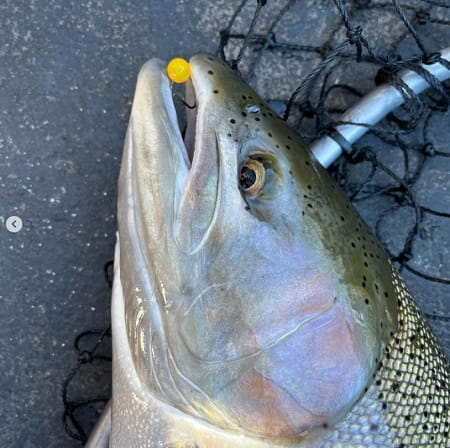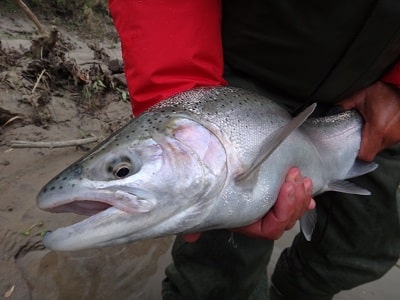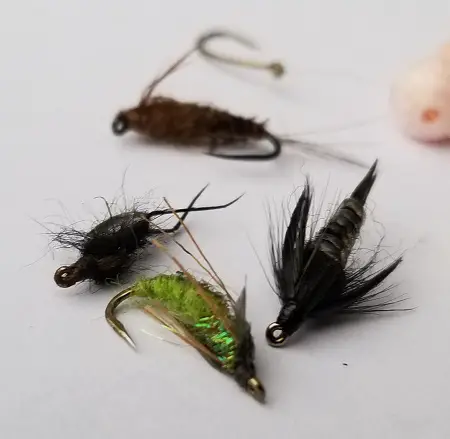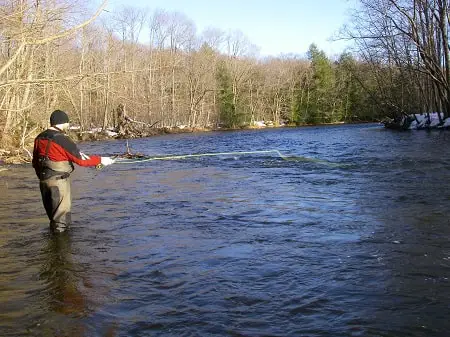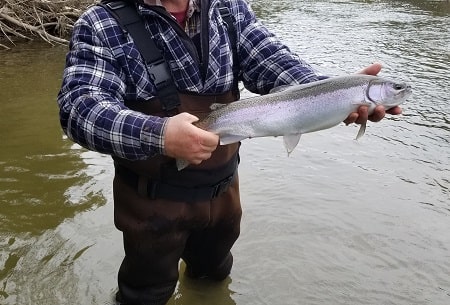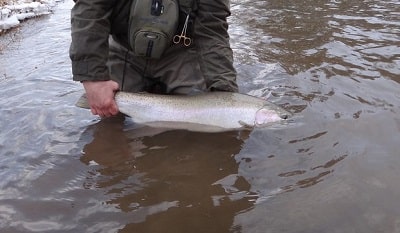Fall Spey Fishing For Steelhead: Proven Guide Tactics
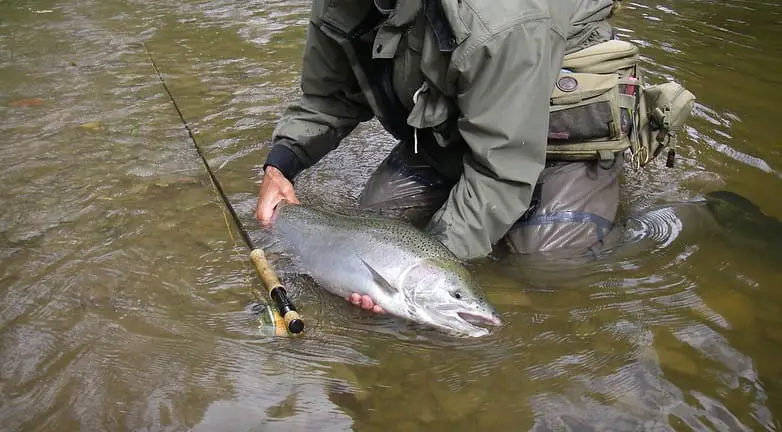
Fall steelhead are aggressive and will hit a well-presented fly which is why fall Spey fishing for steelhead one of the best times for this method.
This article is written by Great Lakes steelhead guide Gareth Thomas from Alley Grabs Guide Service, with insights and additions by guide Graham Bristow
Fall Spey Fishing For Steelhead
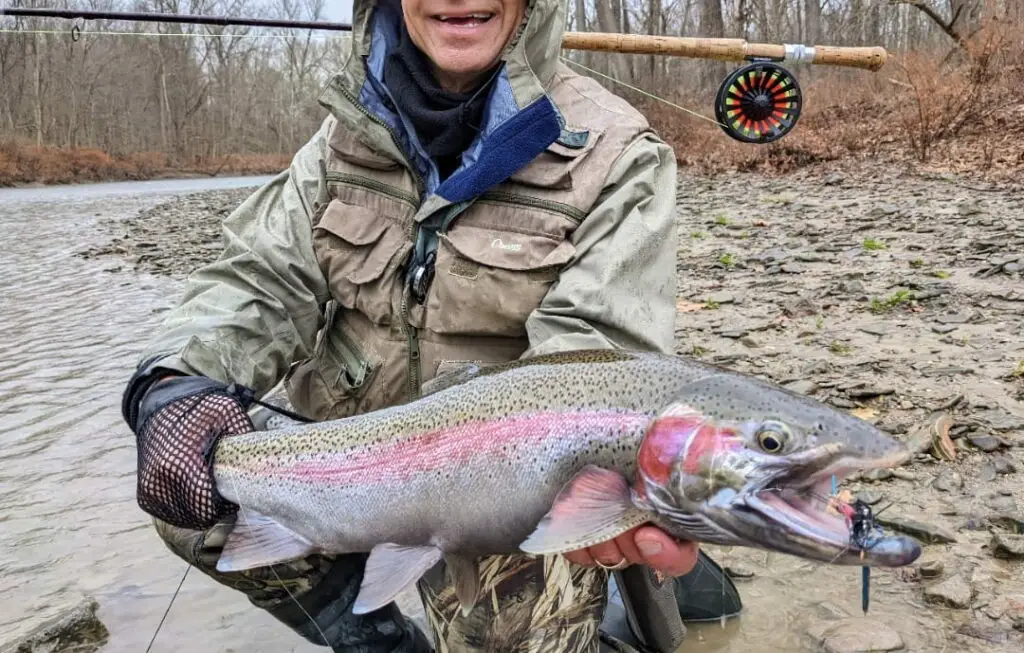
Fall is quickly becoming my favorite season to chase steelhead on the Spey rod here in Ohio.
While the numbers of steelhead holding in the rivers may not be quite as impressive as in spring, the fall gives anglers an opportunity to tangle with the freshest, strongest, most athletic steelhead of the year. If you’d like to stretch your fly-line and test your backing, give fall Spey fishing for steelhead a try!
We discuss fall steelhead fishing in more detail on our page Fall Steelhead Fishing: Proven Guide Tips And Tactics
When And Where For Fall Fishing For Steelhead?
The fall steelhead runs begin at slightly different times of year in different areas of the Great Lakes, but it’s a safe bet that fishable numbers of steelhead will have returned to tributaries in your area by mid-October.
In Ohio, frequent pushes of fresh, aggressive steelhead occur well into December, and opportunities will likely present themselves until the rivers freeze.
In some areas of the Great Lakes and on the West Coast, anglers may see decent numbers of steelhead in the rivers in September and October as steelhead move into the rivers behind the salmon runs. These steelhead will feed heavily on salmon eggs, but they will also crush a well-presented Spey fly.
Graham Bristow: River Guide
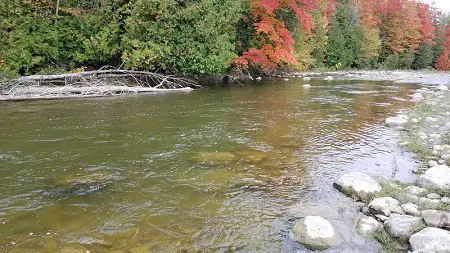
Because the fall season encompasses such a variety of weather conditions, adaptability is the key to success when fall Spey fishing for steelhead. The productive holding water can change on a daily, or even hourly, basis in the fall, owing to rapidly changing conditions.
We’ve all heard the standard description of a likely run for steelhead Spey fishing: three to six feet deep, moving at a brisk walking pace. It’s certainly true a solid majority of steelhead caught in the fall will come from water meeting this description.
However, if we can establish a bit more of a specific pattern when Spey fishing for steelhead, we’ll set ourselves up for success.
Steelhead activity correlates heavily with water temperature. For this reason, I recommend clients focus their attention on shallower, quicker water near the heads and tailouts of long runs when water temperatures exceed 46F, and on the deep guts of runs and pools when temperature trends lower.
It’s important to note that steelhead will react quickly as the temperature fluctuates during the day, and they can often be packed into fast, turbulent water in the afternoon when they’d previously been holed up.
Successful anglers stay open-minded in the fall and cover a variety of water. As I’ll discuss below, there’s no method better suited to covering water quickly and efficiently than Spey fishing.
Gear For Fall Spey Fishing
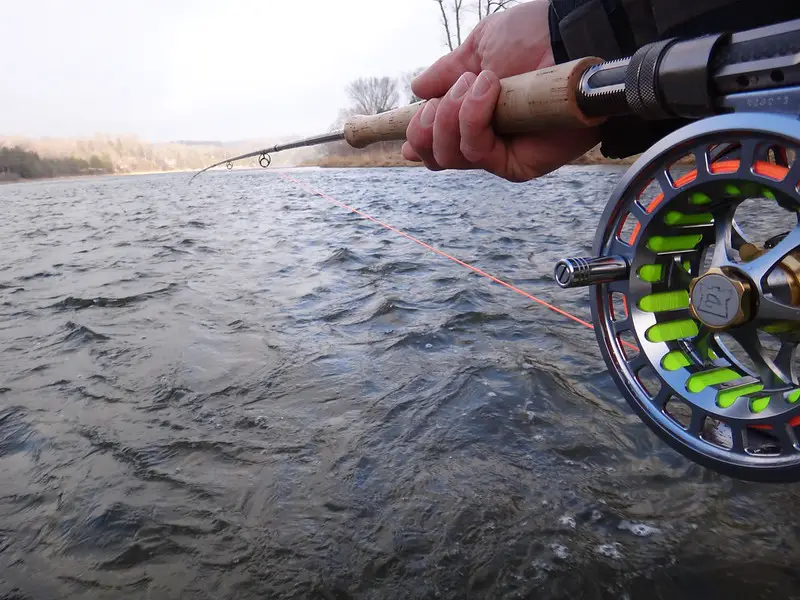
Your terminal tackle will vary according to the size and flow of your home water. Anglers on Ontario or Michigan’s west coasts, for instance, fishing rivers like the Muskegon or the Maitland, will certainly require longer rods and heavier lines than those on my Ohio home rivers.
Switch or Spey rods from 11′-13′ in length, paired with Skagit setups and sink tips from 10′-15′ should be sufficient in most Great Lakes fisheries.
For more on the right size rod, reels, and lines for different rivers, check out Spey Fishing For Steelhead: Best Setup And Tactics.
Select your rods and tips to match the required casting length and fly depth, bearing in mind that your fly should typically swing two to three feet above the bottom while fall Spey fishing.
Fall weather in the Great Lakes is notoriously unpredictable, and anglers should be prepared for any eventuality. I recommend wearing layers under rain gear, which can easily be removed and stored. Plus, if you’re deliberately wearing your raincoat, you can’t forget it in the truck!
Late fall can be winter-like conditions and it can be well below freezing temperatures at times, but if you follow my tips and advice on how I and other guides stay warm when winter fishing you should be fine.
Be sure you have all the right river fishing gear to keep you warm, comfortable, and dry, as well as all the fly fishing gear and the tools to make your trip successful.
Fly Selection For Fall Spey Fishing For Steelhead
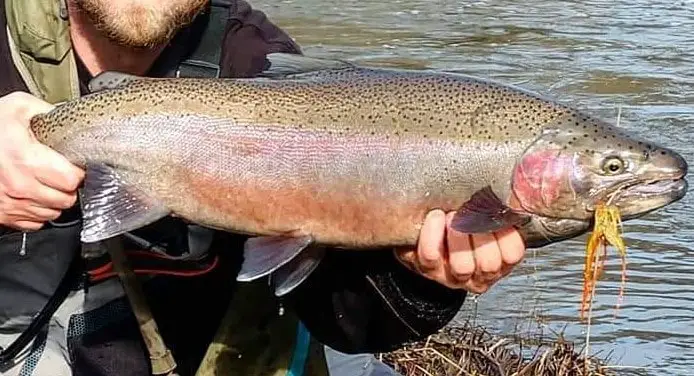
Trout anglers on dry-fly water are often instructed to “match the hatch” to deceive wild trout into taking their flies – they present a fly closely resembling the food source on which the trout are focussed. When fall Spey fishing for steelhead, I recommend anglers follow this same approach.
Lake Erie steelhead feed nearly exclusively on emerald shiner minnows for most of their lives prior to entering the Steelhead Alley tributaries, and they remain keyed-in on this food source for an extended period during their fall run. For this reason, anglers should carry a selection of baitfish imitators like woolly buggers or rabbit leeches in white or olive.
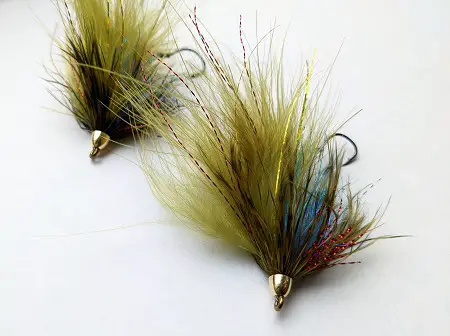
I have a jazzed-up version of the Lil’ Kim which has proven extremely effective (see photo). Learn the baitfish species in your area and carry flies to match.
These flies will account for the majority of the fish caught while fall Spey fishing.
On dark fall days, try large, dark patterns with plenty of movement such as intruders or marabou Spey flies. In bright conditions, orange can be deadly.
How To Approach The Run
Because steelhead are likely to hold in a variety of flows and depths during the fall, covering water quickly and efficiently is the key to finding them. Spey fishing is the perfect way to achieve this.
Position yourself about a cast-length upstream of the uppermost section of productive water in the run you’ve selected. Once you’ve worked out a length of line which you’re confident you can consistently cast, you can begin moving through the run.
Cast downstream at a 45-degree angle and allow the fly to pendulum across the main current until it completely stops below you.
I recommend clients make a slow upriver mend after the cast has landed, in order to orient the line as parallel to the current as possible. Baitfish tend to navigate the river facing directly into the current and your goal should be to imitate this behavior.
Also, it’s rare for a baitfish to move headfirst toward a predator, so every effort should be made to prevent pulling the fly across or down the current. The steelhead will smell a rat right away!
After each cast and swing, you should take three or four large steps downstream before delivering your next cast.
Because an aggressive steelhead will tend to take the fly at the first reasonable opportunity, there is little point in covering the same water more than once with any single fly.
Once you’ve covered the entirety of the run you’ve selected, resume your initial position at the top of the run, change your fly, and then repeat the procedure.
Don’t be shy about taking several large steps between casts. Steelhead have keen eyesight, and will detect your fly from many yards away – and in fall conditions, they’ll be quite happy to chase it down from a distance.
It is vastly preferable to fish through a run two or three times more quickly than once slowly.
Guide Tip: once your fly slows or stops swinging directly below you, some anglers have found that a quick pull of the rod back and forth to jerk or twitch the fly can sometimes trigger a strike from a following steelhead.
Graham Bristow
The Take
The tight-line grab when fall Spey fishing is a sudden, frantic yank at the fly which jolts the arm and rips line from the reel. All your instincts will likely drive you to pull back against the fish in response – but believe it or not, the best way to handle the grab is to do nothing at all.
Allow the fish to burn several yards of line off the reel before assertively raising the rod to engage. Fall steelhead will nearly always hook themselves on the grab, so our goal should simply be to avoid pulling the fly away from them.
After that, hang on tight!
Also, be sure to check out Converting Finicky Steelhead On The Spey and learn how steelhead guides deal with steelhead that tap the fly but don’t fully commit at first.
Late Fall And Winter Tactics
While many anglers give up in late fall and winter when the water starts to get extremely cold and the snow starts, there are many anglers and guides still pursuing and catching plenty of winter steelhead while Spey fishing, you just need to know and use the same winter spey fishing tactics that the guides use.
If you have a question, comment, or some advice on fall Spey fishing for steelhead let us know.
Tight Lines
Gareth

